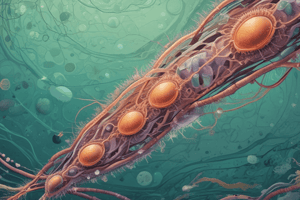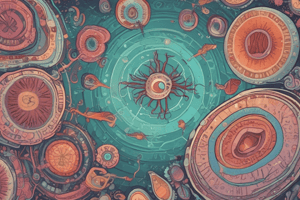Podcast
Questions and Answers
Where is Trichomonas tenax commonly found?
Where is Trichomonas tenax commonly found?
- In the large intestine
- In the oral cavities of humans and animals (correct)
- In fecally contaminated food or water
- In periodontal pockets
Which protozoan is regarded as a commensal organism in the large intestine?
Which protozoan is regarded as a commensal organism in the large intestine?
- Pentatrichomonas hominis (correct)
- Retortamonas intestinalis
- Enteromonas hominis
- Trichomonas tenax
What is the main mode of transmission for Enteromonas hominis and Retortamonas intestinalis?
What is the main mode of transmission for Enteromonas hominis and Retortamonas intestinalis?
- Contaminated dishes and utensils
- Fecal-oral route (correct)
- Blood transfusions
- Kissing
Which of the following flagellates has been associated with periodontal disease?
Which of the following flagellates has been associated with periodontal disease?
How do Trophozoites of Trichomonas tenax primarily feed in the oral cavity?
How do Trophozoites of Trichomonas tenax primarily feed in the oral cavity?
What is the mode of multiplication for Trophozoites of Pentatrichomonas hominis?
What is the mode of multiplication for Trophozoites of Pentatrichomonas hominis?
What is a characteristic feature of Trichomonas hominis trophozoites?
What is a characteristic feature of Trichomonas hominis trophozoites?
How can Trichomonas hominis flagellates be distinguished microscopically?
How can Trichomonas hominis flagellates be distinguished microscopically?
Which characteristic distinguishes Enteromonas hominis from Endolimax nana cysts?
Which characteristic distinguishes Enteromonas hominis from Endolimax nana cysts?
What is the main cause of Enteromonas hominis infection in humans?
What is the main cause of Enteromonas hominis infection in humans?
Which flagellate is considered non-pathogenic despite being associated with diarrheic stools?
Which flagellate is considered non-pathogenic despite being associated with diarrheic stools?
What diagnostic feature is seen in Trichomonas hominis but not in Enteromonas hominis?
What diagnostic feature is seen in Trichomonas hominis but not in Enteromonas hominis?
Which flagellate is considered non-pathogenic and commonly found in crowded places with poor sanitation practices?
Which flagellate is considered non-pathogenic and commonly found in crowded places with poor sanitation practices?
What is a characteristic feature of Trichomonas tenax morphology?
What is a characteristic feature of Trichomonas tenax morphology?
Which flagellate is transmissible through contaminated water and sometimes a potential cause of childhood dysentery?
Which flagellate is transmissible through contaminated water and sometimes a potential cause of childhood dysentery?
What is a unique characteristic of Retortamonas intestinalis morphology?
What is a unique characteristic of Retortamonas intestinalis morphology?
Which flagellate has no known cyst stage and only trophozoites are shed in feces?
Which flagellate has no known cyst stage and only trophozoites are shed in feces?
What distinguishes Enteromonas hominis from the other mentioned flagellates?
What distinguishes Enteromonas hominis from the other mentioned flagellates?
Study Notes
Trichomonas hominis
- Cosmopolitan distribution, non-pathogenic, and associated with diarrheic stools
- Most commonly found flagellate next to Giardia lamblia and Dientamoeba fragilis
- Flagellates move rapidly in a jerky, non-directional manner
- Axostyle and undulating membrane are diagnostic
- No cyst stage, only trophozoites
Morphology of Trichomonas hominis
- Size: 7-20 um long, 5-18 um wide
- Shape: Pear-shaped
- Motility: Nervous, jerky
- Nucleus: One, with a small central karyosome, no peripheral chromatin
- Flagella: 3-5 anterior, 1 posterior extending from the posterior end of the undulating membrane
- Axostyle extends beyond the posterior end of the body
- Full body length undulating membrane
- Conical cytostome cleft in anterior region ventrally located opposite the undulating membrane
Enteromonas hominis
- Distributed worldwide in warm and temperate climates
- Ingestion of cysts appears to be the primary cause
- Considered as non-pathogenic
- E.hominis cysts overlap with Endolimax nana cysts, binucleated cysts indicate probable E.hominis
- Infection occurs after ingestion of cysts in fecally contaminated food or water, or on fomites
Morphology of Enteromonas hominis
- Cyst characteristics:
- Size: 3-10 um long, 4-7 um wide
- Shape: Oval, elongated
- Nucleus: 1-4, binucleated and quadrinucleated nuclei located at opposite ends, central karyosome, no peripheral chromatin
- Trophozoite characteristics:
- Size: 3-10 um long, 3-7 um wide
- Shape: Oval, sometimes half-circle
- Motility: Jerky
- Nucleus: One, with central karyosome, no peripheral chromatin
- Flagella: 4; 3 directed anteriorly, 1 directed posteriorly
- Axostyle that extends beyond the posterior end of the body
Trichomonas tenax
- Anaerobic flagellated protozoan found in the oral cavities of humans and animals
- Associated with periodontal disease
- Most prevalent inflammatory disease affecting oral cavities
- Evidence suggests that it can cause damage to mammalian cells and secrete virulent proteins, such as cysteine
- Trophozoites survive in the body as mouth scavengers that feed primarily on local microorganisms
Morphology of Trichomonas tenax
- Size: 3-10 um long, 4-7 um wide
- Shape: Oval, elongated
- Nucleus: 1-4, binucleated and quadrinucleated nuclei located at opposite ends, central karyosome, no peripheral chromatin
- No other structures
Retortamonas intestinalis
- Rarely reported in clinical stool samples
- Distributed worldwide in warm and temperate climates
- Ingestion of cysts appears to be the primary cause
- Common in crowded places with poor sanitation practices
- Considered as non-pathogenic
Morphology of Retortamonas intestinalis
- Cyst characteristics:
- Size: 3-9 um long, up to 5 um wide
- Shape: Lemon-shaped, pear-shaped
- Nucleus: 1, located in anterior-central region with central karyosome, may be surrounded by a delicate ring of chromatin granules
- 2 fused fibrils resembling a bird’s beak in the anterior nuclear region, only visible in stained preparations
- Trophozoite characteristics:
- Size: 3-7 um long, 5-6 um wide
- Shape: Ovoid
- Motility: Jerky
- Nucleus: One, with small central karyosome, ring of chromatin granules on nuclear membrane
- Flagella: 2, anterior
- Cytostome extending halfway down body length with well-defined fibril border opposite the nucleus in the anterior end
Pentatrichomonas hominis
- Common in some animals, like rats and cats
- Considered as non-pathogenic
- Transmissible through contaminated water, also sometimes a potential cause of childhood dysentery
Morphology of Pentatrichomonas hominis
- Size: 8-20 μm long, 3-14 μm wide
- Flagella: 5 anterior flagella plus 1 posterior flagellum
- No cyst stage, only trophozoites
Studying That Suits You
Use AI to generate personalized quizzes and flashcards to suit your learning preferences.
Description
Learn about the morphology and characteristics of Trichomonas hominis, an intestinal flagellate with a cosmopolitan distribution. Understand its non-pathogenic nature and its association with diarrheic stools. Explore its rapid jerky movement, axostyle, undulating membrane, and staining difficulties.




